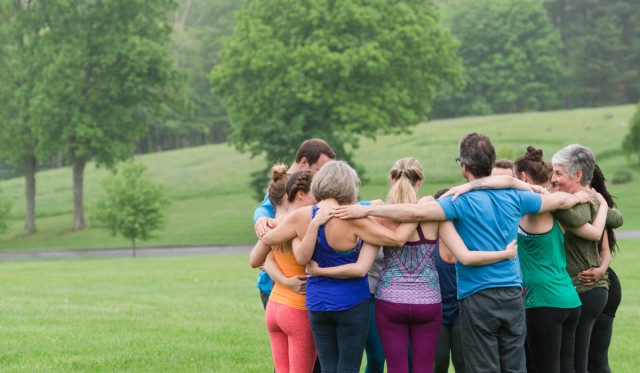Break the Cycle: How Yoga and Meditation Can Help Heal Addiction

What characterizes an addiction? Quite simply this: you no longer feel that you have the choice to stop.
—Eckhart Tolle, The Power of Now
While there are a range of ways that people break the cycle of addiction, Alcoholics Anonymous (AA) and its Twelve-Step approach has become one of the most well known, accessible, and affordable ways (it’s free) to get clean and sober, and has come to signify the Western approach to recovery. It’s more than the promise of abstinence, however, that attracts people to the Twelve Steps.
“Addiction itself can be a misguided spiritual search,” says Kevin Griffin, author of One Breath at a Time: Buddhism and the Twelve Steps and cofounder of the Buddhist Recovery Network (BRN). “Many people who don’t see themselves as particularly spiritual find that when they get sober they have some longing in them, and that their addiction, in one form or another, has been a longing for connection. This is a very common experience.”
Though there is no spiritual or religious requirement to practice the Twelve Steps, at the heart of any Twelve-Step recovery program is the importance of adopting a spiritual approach to life. “The point is that we are willing to grow along spiritual lines,” states the bible of Alcoholics Anonymous (the Big Book). First published in 1939, this main text offers detailed instructions for prayer and, to a lesser degree, meditation, but it doesn’t address, in any significant way, the role that a bodymind connection can play in the healing process.
Aruni Nan Futuronsky, a Kripalu Senior Life Coach and Kripalu Yoga teacher, says that the complementary relationship between the Twelve Steps and yoga is a perfect marriage for healing. “Addiction is the ultimate checking out of the moment … Yoga, on and off the mat, is the checking in to reality,” she says. “Brilliantly, yoga and recovery programs work together to cover all bases.”
Bodymind practices aside, there are many parallels between the benefits reaped from Eastern practices, like yoga and meditation, and the benefits produced as a result of working the Twelve Steps—self-acceptance for one, the importance of staying in the moment another. Kevin connects Buddhism’s Eightfold Path directly with the Twelve Steps. The First Noble Truth “is that there is suffering. The Second Noble Truth is that the cause of suffering is clinging, or craving,” he says. “And if [meditation] practice works with suffering, with clinging and craving, it’s going to help with addiction. And it does.”
The Big Book promises that anyone can get and stay clean if they practice “rigorous honesty.” “Mindfulness,” says Kevin, a member of a Twelve-Step group himself, “is a form of existential honesty. What is true in this moment? Both the Steps and meditation really demand a presence and a willingness to look at what is real and true.”
Although he has stopped assuming there is any one way to get and stay sober, Griffin will still encourage attendance at Twelve-Step meetings to students who are initially resistant, and will also refer them to the BRN, which “supports the use of Buddhist teachings, traditions, and practices to help people recover from the suffering caused by addictive behaviors.” BRN meetings are not affiliated with any Twelve-Step program, but as Griffin points out, they have some similarities to a Twelve-Step meeting. “There’s sharing. There’s someone who leads. You meditate together as a group. [Even] if you don’t want to do Twelve-Step, you still need support.”
Nikki Myers, cofounder of Y12SR, the Yoga of 12-Step Recovery, notes that she often comes across recovering addicts who only want to do yoga and not go to Twelve-Step meetings. With a history of relapse in her own recovery, Nikki knows what awaits some people who go down that path. “I replaced meetings and [Twelve-Step] program work with yoga. The relapse proved the ineffectiveness of that path for me. I had the realization that it takes both, and that brought me to a more integrated recovery approach.” Nikki uses models from the Yoga Sutras, the Upanishads, the Bhagavad Gita, and other sacred texts to help expand their students’ awareness. “A Twelve-Step program approaches addiction at a cognitive level,” says Nikki, “and yoga includes a somatic approach. The combining of the two creates a model that truly addresses addiction as the physical, mental, and spiritual dis-ease that it is.”
A recovering alcoholic sober for nine years who asked to remain anonymous explained her experience of being on the verge of relapse, and how adding the bodymind approach helped her turn a tough corner. “Four years into my recovery,” she says, “I started to question whether or not the Twelve Steps worked at all and if it was even worth it to be sober. I wasn’t drinking, but my addictive tendencies were making the rounds in different areas of my life, so I still felt crazy and restless and unhappy. At the suggestion of a fellow recovering alcoholic, I signed up for a yoga class. In yoga postures, I got introduced to how frenetic and negative my thinking was, and I knew that that’s where the change needed to happen. Abstinence from alcohol wasn’t enough. Eventually I started a meditation practice, which is where I get to both observe and train my mind.”
The Eastern perspective on addiction is that it’s not a separate ailment, but rather a condition on the continuum of human suffering. Rolf Gates, master yoga teacher, addictions counselor, and author of Meditations from the Mat, puts it this way: “In the Western medical model, addiction is treated as something outside of the ordinary. In the Eastern approach to suffering, attachment to the pleasant and aversion to the unpleasant is seen as a constant, and so addiction is just an extreme manifestation of an ordinary attachment to the pleasant and aversion to the unpleasant.”
The difference in perspective, however, doesn’t change the structure of the approach to healing. “The Western approach to addiction generally falls into what is called cognitive behavioral therapy,” Rolf adds, “which focuses one’s attention on the problem and supports a person in the practice of new behaviors. A yoga or meditation teacher draws one’s attention to the cause of suffering and supports the student in practicing new behaviors. As a result, the Eastern and Western approaches to treatment are almost identical.”
Whether it’s found through therapy, the Twelve Steps, a bodymind approach, or a combination of all three, the experience of spiritual well-being seems to be the key to helping many people break the cycle of addiction in their lives. “A longing for something lurks at the bottom of the issue of addiction,” Aruni says, echoing Kevin’s observation. “Aren’t all addicts seekers, wanting something extraordinary, something magical, to soothe them?” And what better magic to add to the path of clean living than yoga and meditation?
A person in recovery, or anyone hungry for spiritual connection, is wise to take what Rolf says to heart: “It is my understanding that the Buddha told his students that there is only one mistake you can make on the path to awakening, and that is to stop.”

